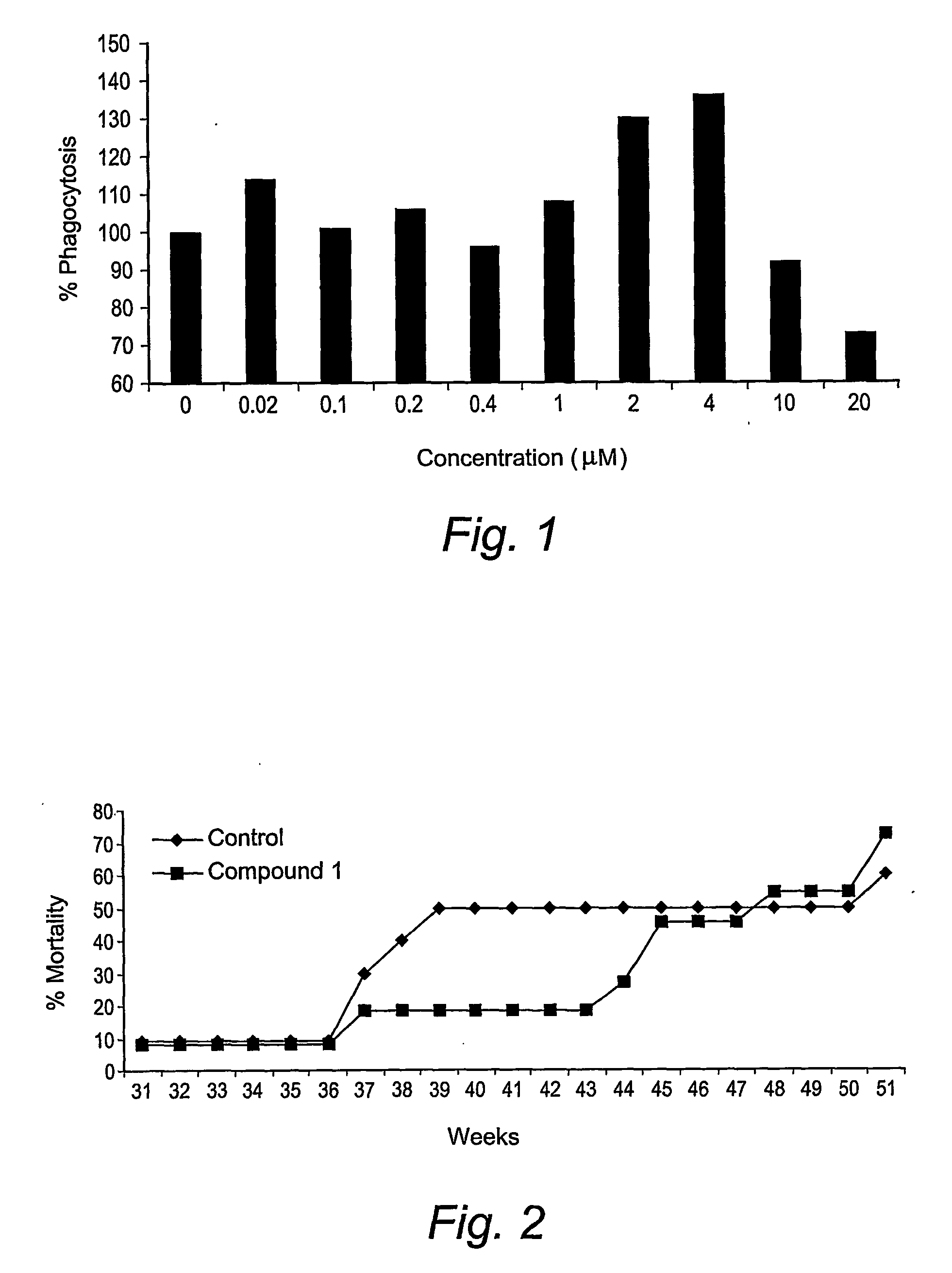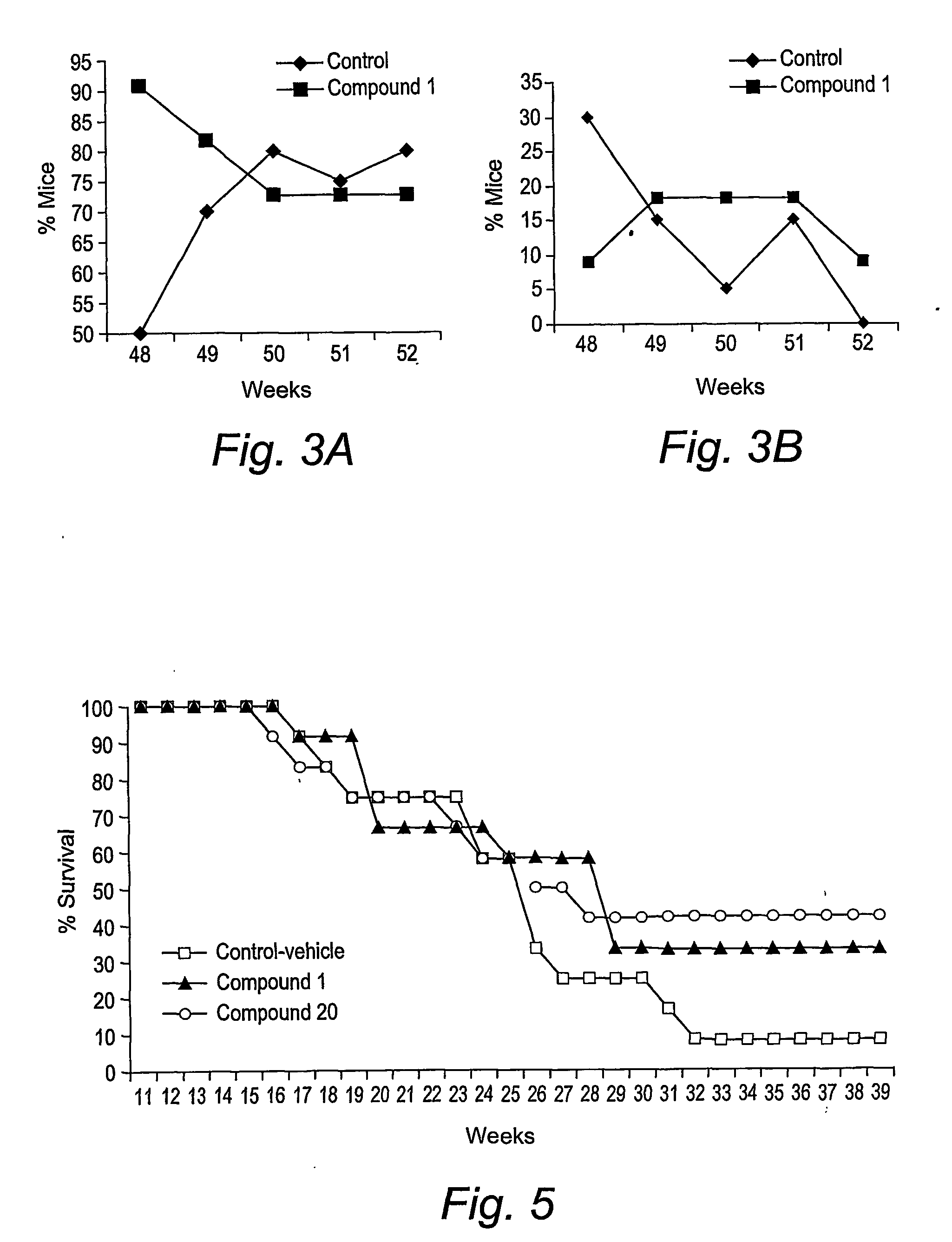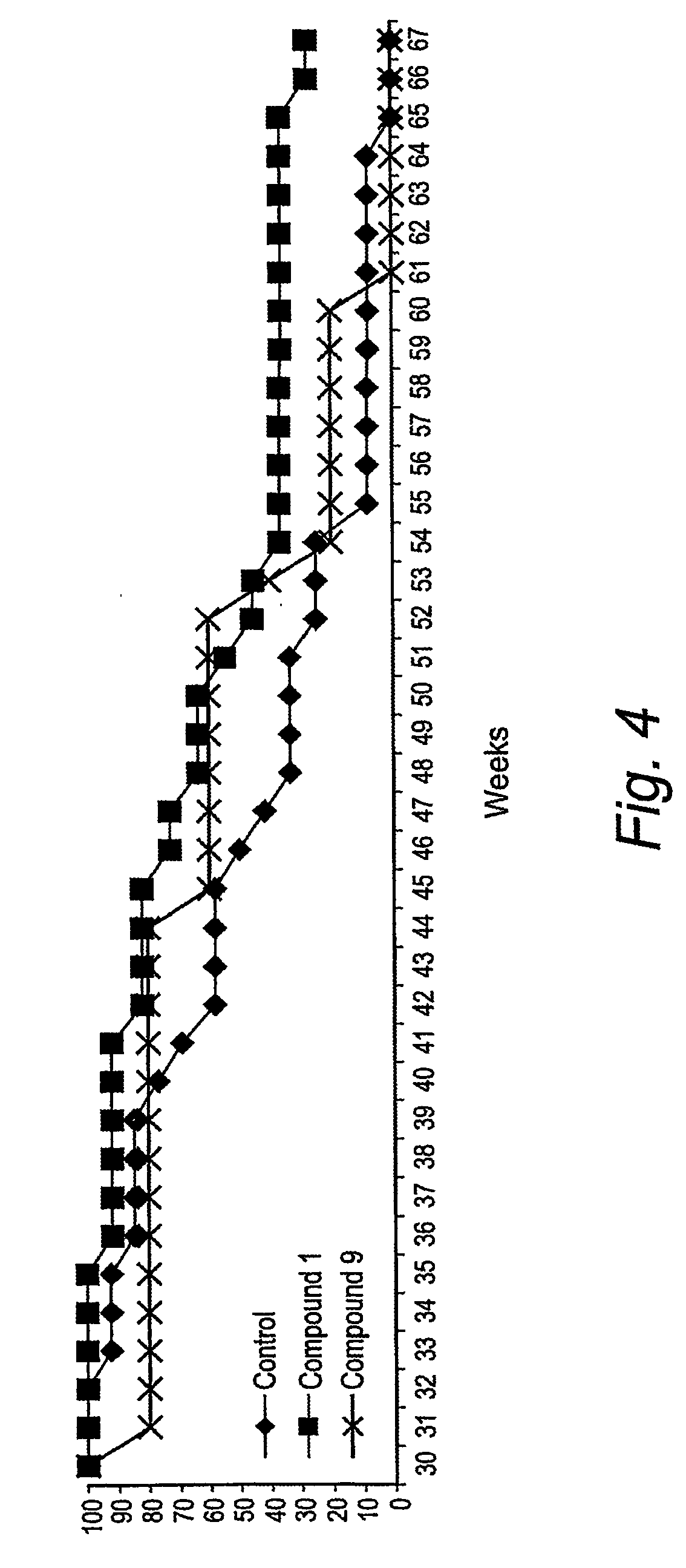Triazine dimers for the treatment of autoimmune diseases
a technology of autoimmune diseases and triazine dimers, which is applied in the field of treatment of autoimmune diseases, can solve the problems of inability to meet the needs of patients, etc., to achieve the effect of reducing the accumulation of tnf, and facilitating the clearance of immune complexes
- Summary
- Abstract
- Description
- Claims
- Application Information
AI Technical Summary
Benefits of technology
Problems solved by technology
Method used
Image
Examples
example 1
Representative Example of Scheme I Method A: Synthesis of Compound 1
[0065][0066] To a suspension of cyanuric chloride (20 g, 108 mmol) in acetone (120 mL) and ice (50 mL) at 0° C. was added dropwise a solution of aniline (10 g, 107 mmol) in acetone (45 mL). At the end of the addition, the pH of the solution was adjusted from 1 to 7 with 5% aqueous sodium bicarbonate (150 mL). The precipitate was filtered, washed several times with water and dried in vacuo. This gave 2,4dichloro-6-phenylamino-1,3,5-triazine as an off-white solid (24.3 g, 93% yield). The product was used in the next step without further purification. To a solution of the dichlorotriazine (6.2 g, 25.7 mmol) in THF (300 mL) at room temperature was added a solution of 2-(4-hydroxyphenyl)ethylamine (3.6 g, 25.9 mmol) in acetone (100 mL) and water (100 mL), followed by 5% aqueous sodium bicarbonate (50 mL). After 20 h reaction at room temperature, the solution was diluted with water (50 mL) and ethyl acetate (50 mL). The a...
example 2
A Representative Example of Scheme II Method A: Synthesis of Compound 17
[0067][0068] To a solution of 2,4-dichloro-6-anophenyl-1,3,5-triazine (1.6 g, 6.6 mmol) in THF (70 mL) at room temperature was added a solution of ethanolamine (439 mg, 7.3 mmol) in acetone (24 mL) and water (24 mL), followed by 5% aqueous sodium bicarbonate (15 mL). The reaction was stirred for 20 h at room temperature. The mixture was then diluted with water (25 mL) and ethyl acetate (25 mL). The aqueous layer was extracted with ethyl acetate (2×25 mL). The organic layer was washed with brine (50 mL), dried over anhydrous sodium sulphate, filtered and concentrated under reduced pressure. The crude residue was purified on a Biotage™ 40S column (silica, hexane / AcOEt 9:1 to 0:1) to yield 2-chloro4-(2-hydroxyethylannno)-6-aminophenyl-1,3,5-triazine as a white solid (1.6 g, 91% yield). This compound (710 mg, 2.7 mmol) was dissolved in THF (26 mL) and 2-(4-aminophenyl)ethylamine (1.1 mL, 8.0 mmol) was added followed...
example 3
A Representative Example of Scheme 11 Method B: Solid Phase Synthesis of Compound 16
[0069][0070] Reagents: (a) 1) 1,4-diaminobutane, dichloromethane, 17.5 h, 400 rpm; 2) MeOH DIEA, 25° C., 1 h, 400 rpm; (b) cyanuric chloride, DIEA, THF, 25° C., 30 min., 400 rpm; (c) aniline, DIEA, NMP, 50° C., 24 h, 400 rpm; (d) 2-(4-aminophenyl)ethylamine, NMP, 80° C., 20 h, 400 rpm; (e) 2-(4-hydroxyphenyl)ethylamine, DIEA, NMP, 80° C. 20 h, 400 rpm; (f) 5% trifiuoroacetic acid / dichloroethane, 25° C., 1 h, 400 rpm
Instrumentation [0071] The solid phase synthesis was performed in Bohdan Miniblocks. They were in sets of two, possessing forty-eight polypropylene reaction tubes. Each tube had a frit at the bottom for filtration of the solid support. A screw acting as a valve allows (or not) the flow of liquids. A heat transfer block surrounding all the tubes was added to provide appropriate heating of the reactions. The heat transfer blocks were coupled to a Julabo FP 40 refrigerated heating circulato...
PUM
| Property | Measurement | Unit |
|---|---|---|
| temperature | aaaaa | aaaaa |
| temperature | aaaaa | aaaaa |
| cellular stress | aaaaa | aaaaa |
Abstract
Description
Claims
Application Information
 Login to View More
Login to View More - R&D
- Intellectual Property
- Life Sciences
- Materials
- Tech Scout
- Unparalleled Data Quality
- Higher Quality Content
- 60% Fewer Hallucinations
Browse by: Latest US Patents, China's latest patents, Technical Efficacy Thesaurus, Application Domain, Technology Topic, Popular Technical Reports.
© 2025 PatSnap. All rights reserved.Legal|Privacy policy|Modern Slavery Act Transparency Statement|Sitemap|About US| Contact US: help@patsnap.com



